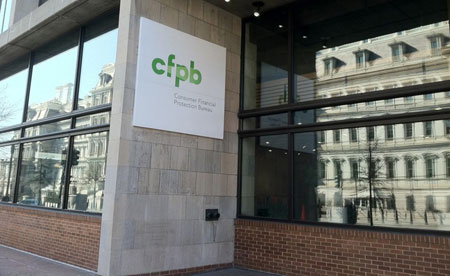
Updated Servicing Rule Provides Surviving Family Members and Other Homeowners with Same Protections as Original Borrowers
Washington, D.C. (August 4, 2016) – The Consumer Financial Protection Bureau (CFPB) today finalized new measures to ensure that homeowners and struggling borrowers are treated fairly by mortgage servicers. The updated rule requires servicers to provide certain borrowers with foreclosure protections more than once over the life of the loan, clarifies borrower protections when the servicing of a loan is transferred, and provides important loan information to borrowers in bankruptcy. The changes also help ensure that surviving family members and others who inherit or receive property generally have the same protections under the CFPB’s mortgage servicing rules as the original borrower.
“The Consumer Bureau is committed to ensuring that homeowners and struggling borrowers are treated fairly by mortgage servicers and that no one is wrongly foreclosed upon,” said CFPB Director Richard Cordray. “These updates to the rule will give greater protections to mortgage borrowers, particularly surviving family members and other successors in interest, who often are especially vulnerable.”
Mortgage servicers are responsible for collecting payments from the mortgage borrower and forwarding those payments to the owner of the loan. They typically handle customer service, collections, loan modifications, and foreclosures. To address widespread mortgage servicing problems, the CFPB established common-sense rules for servicers that went into effect on January 10, 2014.
The CFPB issued proposed amendments to those rules in November 2014, and the final rule issued today adopts many of the proposed provisions. However, the Bureau made a number of changes in the final rule after considering comments received from the public.
The rule issued today establishes new protections for consumers, including:
- Requiring servicers to provide certain borrowers with foreclosure protections more than once over the life of the loan: Under the CFPB’s existing rules, a mortgage servicer must give borrowers certain foreclosure protections, including the right to be evaluated under the CFPB’s requirements for options to avoid foreclosure, only once during the life of the loan. Today’s final rule will require that servicers give those protections again for borrowers who have brought their loans current at any time since submitting the prior complete loss mitigation application. This change will be particularly helpful for borrowers who obtain a permanent loan modification and later suffer an unrelated hardship – such as the loss of a job or the death of a family member – that could otherwise cause them to face foreclosure.
- Expanding consumer protections to surviving family members and other homeowners: If a borrower dies, existing CFPB rules require that servicers have policies and procedures in place to promptly identify and communicate with family members, heirs, or other parties, known as “successors in interest,” who have a legal interest in the home. Today’s final rule establishes a broad definition of successor in interest that generally includes persons who receive property upon the death of a relative or joint tenant; as a result of a divorce or legal separation; through certain trusts; or from a spouse or parent. The final rule ensures that those confirmed as successors in interest will generally receive the same protections under the CFPB’s mortgage servicing rules as the original borrower.
- Providing more information to borrowers in bankruptcy: Under the CFPB’s existing mortgage rules, servicers do not have to provide periodic statements or early intervention loss mitigation information to borrowers in bankruptcy. Today’s final rule generally requires, subject to certain exemptions, that servicers provide those borrowers periodic statements with specific information tailored for bankruptcy, as well as a modified written early intervention notice to let those borrowers know about loss mitigation options. Servicers also currently do not have to provide early intervention loss mitigation information to borrowers who have told the servicer to stop contacting them under the Fair Debt Collection Practices Act. Today’s final rule generally requires servicers to provide modified written early intervention notices to let those borrowers also know about loss mitigation options.
- Requiring servicers to notify borrowers when loss mitigation applications are complete: Whether a borrower is entitled to key foreclosure protections depends in part on the date a borrower completes a loss mitigation application. If consumers do not know the status of their application, they cannot know the status of those foreclosure protections. Today’s final rule requires servicers to notify borrowers promptly and in writing that the application is complete, so that borrowers know the status of the application and have more information about their protections.
- Protecting struggling borrowers during servicing transfers: When mortgages are transferred from one servicer to another, borrowers who had applied to the prior servicer for loss mitigation may not know where they stand with the new servicer. Today’s final rule clarifies that generally the new servicer must comply with the loss mitigation requirements within the same timeframes that applied to the transferor servicer, but provides limited extensions to these timeframes under certain circumstances. If a borrower submits an application shortly before transfer, the new servicer must send an acknowledgment notice within 10 business days of the transfer date. If the borrower’s application was complete prior to transfer, the new servicer must evaluate it within 30 days of the transfer date. If the new servicer needs more information to evaluate the application, the borrower would retain some foreclosure protections in the meantime. If the borrower submits an appeal, the new servicer has 30 days to make a determination on the appeal.
- Clarifying servicers’ obligations to avoid dual-tracking and prevent wrongful foreclosures: The CFPB’s existing rules prohibit servicers from taking certain actions in foreclosure once they receive a complete loss mitigation application from a borrower more than 37 days prior to a scheduled sale. However, in some cases, borrowers are not receiving this protection, and servicers’ foreclosure counsel may not be taking adequate steps to delay foreclosure proceedings or sales. The CFPB’s new rule clarifies that, if a servicer has already made the first foreclosure notice or filing and receives a timely complete application, servicers and their foreclosure counsel must not move for a foreclosure judgment or order of sale, or conduct a foreclosure sale, even if a third party conducts the sale proceedings, unless the borrower’s loss mitigation application is properly denied, withdrawn, or the borrower fails to perform on a loss mitigation agreement. The clarifications will aid servicers in complying with, and assist courts in applying, the dual-tracking prohibitions in foreclosure proceedings to prevent wrongful foreclosures.
- Clarifying when a borrower becomes delinquent: Several of the consumer protections under the CFPB’s existing rules depend upon how long a consumer has been delinquent on a mortgage. Today’s final rule clarifies that delinquency, for purposes of the servicing rules, begins on the date a borrower’s periodic payment becomes due and unpaid. When a borrower misses a periodic payment but later makes it up, if the servicer applies that payment to the oldest outstanding periodic payment, the date the borrower’s delinquency began advances. The final rule also allows servicers the discretion, under certain circumstances, to consider a borrower as having made a timely payment even if the borrower’s payment falls short of a full periodic payment. The increased clarity will help ensure borrowers are treated uniformly and fairly.
Today’s final rule makes additional changes to the CFPB’s mortgage servicing rules. These changes include providing flexibility for servicers to comply with certain force-placed insurance and periodic statement disclosure requirements. The changes also clarify several requirements regarding early intervention, loss mitigation, information requests, and prompt crediting of payments, as well as the small servicer exemption. Further, the changes exempt servicers from providing periodic statements under certain circumstances when the servicer has charged off the mortgage. Finally, concurrently with the final rule, the CFPB is issuing an interpretive rule under the Fair Debt Collection Practices Act relating to servicers’ compliance with certain mortgage servicing provisions as amended by the final rule.
Most of the provisions of the final rule will take effect 12 months after publication in the Federal Register. The provisions relating to successors in interest and the provisions relating to periodic statements for borrowers in bankruptcy will take effect 18 months after publication in the Federal Register.
The Consumer Financial Protection Bureau is a 21st century agency that helps consumer finance markets work by making rules more effective, by consistently and fairly enforcing those rules, and by empowering consumers to take more control over their economic lives. For more information, visit www.consumerfinance.gov.














Comments